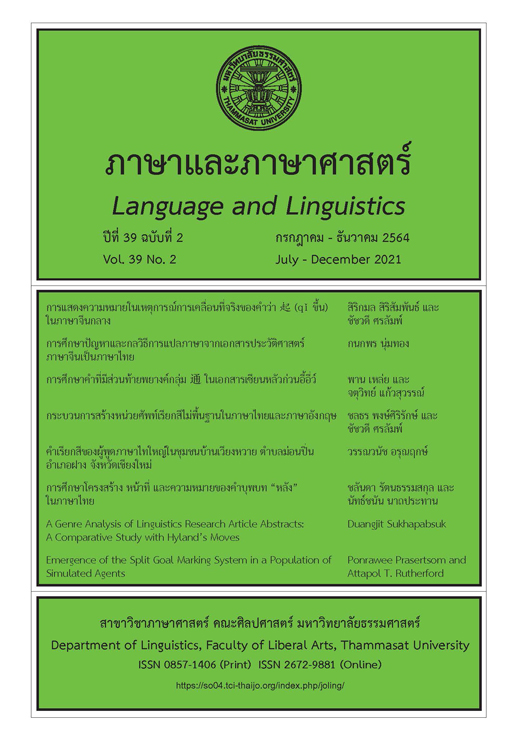Color Terms of Shan Language Speakers in Ban Wiang Wai, Monpin Sub-District, Fang District, Chiangmai Province
Main Article Content
Abstract
This article aims to study the number of basic color terms and their evolution in Shan language speakers in Ban Wiang Wai, Monpin Sub-District, Fang District, Chiangmai Province according to the theory of Berlin and Kay (Berlin & Kay, 1991) and the theory of strategies for forming words in the Shan language. The data were collected from 20 Shan people whose ages ranged between 50-60. The result of this study indicated that the numbers of basic color terms in Shan comprised 11 words, namely /kha:w1/ (white) /lam1/ (black) /lɛ:ŋ1/ (red) /khe:w1/ (green) /lə:ŋ1/ (yellow) /sɔm2/ (blue) /nam5tha:n1/ (brown) /mo:ŋ5/ (purple) /khɔŋ2/ (pink) /som5/ (orange) and /taw4/ (grey). The evolution of basic color terms in the Shan language is at the 7th stage. It accords with the theory of Berlin and Kay. Regarding non-basic color terms, the Shan language has four strategies for forming non-basic color terms: by using specific color terms; combining color terms; combining color terms with modifying words; using the names of specific objects as color terms. This study found that the most used strategies for forming non-basic color terms in this sample group was “using names of the specific objects as color terms”. We argue that this is because Shan people are continually influenced by, and are accepting of, urban society, and also because they have a way of life which is close to nature.
Article Details
บทความทุกบทความเป็นลิขสิทธิ์ของภาษาและภาษาศาสตร์
References
แก่นจันทร์ มะลิซอ. (2546). การออกแบบผลิตภัณฑ์จากผ้าทอไทใหญ่ บ้านใหม่หมอกจ๋าม อำเภอแม่อาย จังหวัดเชียงใหม่ [วิทยานิพนธ์ปริญญามหาบัณฑิต]. มหาวิทยาลัยเชียงใหม่.
จรรยา พนาวงค์ และอุไรวรรณ แก้วคำมูล. (2546). ประวัติศาสตร์ชุมชนบ้านเวียงหวาย ตำบลม่อนปิ่น อำเภอฝาง จังหวัดเชียงใหม่. ม.ป.พ.
ฉียูน เจียง. (2560). การเปรียบเทียบคำเรียกสีและการรับรู้สีในภาษาไทยของชาวกรุงเทพฯ กับภาษาจีนของชาวฮั่นในนครหนานหนิง [วิทยานิพนธ์ปริญญามหาบัณฑิต]. มหาวิทยาลัยธรรมศาสตร์.
ณรงค์กรรณ รอดทรัพย์. (2555). คำเรียกสีในภาษาม้งขาว. วารสารมหาวิทยาลัยหัวเฉียวเฉลิมพระเกียรติวิชาการ, 16(31), 77-88.
ธนัฏฐากุล พรทิพยพานิช. (2557). คำเรียกสีในภาษาไทยสมัยธนบุรีและสมัยรัตนโกสินทร์ [วิทยานิพนธ์ปริญญามหาบัณฑิต]. มหาวิทยาลัยเกษตรศาสตร์.
ธนานันท์ ตรงดี. (2541). คำเรียกสีเงาะป่า(ซาไก). วารสารสงขลานครินทร์ ฉบับสังคมศาสตร์และมนุษยศาสตร์, 4(2), 197-214.
นฤมล ศิริพันธุ์. (2554). คำเรียกสีและทัศนคติที่มีต่อสีของผู้พูดภาษาไทย กะเหรี่ยงโปว์ มอญ และขมุ ในอำเภอศรีสวัสดิ์ จังหวัดกาญจนบุรี [วิทยานิพนธ์ปริญญามหาบัณฑิต]. มหาวิทยาลัยศิลปากร.
บรรจบ พันธุเมธา. (2508). ลักษณะภาษาไทยใหญ่เทียบกับภาษาไทยกรุงเทพฯ. ม.ป.พ.
มหาวิทยาลัยราชภัฏเชียงใหม่. (2552). พจนานุกรมภาษาไทใหญ่-ไทย (พิมพ์ครั้งที่ 2). แสงศิลป์.
วัลยา ช้างขวัญยืน, กาญจนา นาคสกุล, วิรุฬห์รัตน์ ไฉนงุ้น, และอนันต์ เหล่าเลิศวรกุล. (2553). คำ การสร้างคำ และการยืมคำ (พิมพ์ครั้งที่ 2). โรงพิมพ์สกสค. ลาดพร้าว.
วินัย ภู่ระหงษ์. (2531). หน่วยคำและการประกอบคำในภาษาไทย. ใน เอกสารการสอนชุดวิชาภาษาไทย 3 (Thai 3) หน่วย 7-15 (พิมพ์ครั้งที่ 3, น. 70-85). มหาวิทยาลัยสุโขทัยธรรมาธิราช.
ศตนันต์ เชื้อมหาวัน. (2541). คำเรียกสีและการรับรู้สีของผู้พูดภาษาไทลื้อ ลัวะ ม้ง และกะเหรี่ยงในพื้นที่จังหวัดเชียงรายและพะเยา [วิทยานิพนธ์ปริญญามหาบัณฑิต]. จุฬาลงกรณ์มหาวิทยาลัย.
ศราวุธ หล่อดี. (2561). คำเรียกสีและมโนทัศน์เกี่ยวกับสีในภาษาล้านนา [วิทยานิพนธ์ปริญญาดุษฎีบัณฑิต]. มหาวิทยาลัยพะเยา.
ศุภมาส เอ่งฉ้วน. (2543). คำเรียกสีและมโนทัศน์เรื่องสีของคนไทยสมัยสุโขทัยและสมัยปัจจุบัน [วิทยานิพนธ์ปริญญาดุษฎีบัณฑิต]. จุฬาลงกรณ์มหาวิทยาลัย.
อภิญญา เพชรวิชิต. (2545). การสร้างคำเรียกสีในภาษาไทยและภาษาลาว [การศึกษาค้นคว้าอิสระปริญญามหาบัณฑิต]. มหาวิทยาลัยมหาสารคาม.
อมรา ประสิทธิ์รัฐสินธุ์. (2538). คำเรียกสีและการรับรู้สีของชาวจ้วงและชาวไทย. โรงพิมพ์จุฬาลงกรณ์มหาวิทยาลัย.
Berlin, B., & Kay, P. (1991). Basic color terms: Their universality and evolution. University of California Press.


